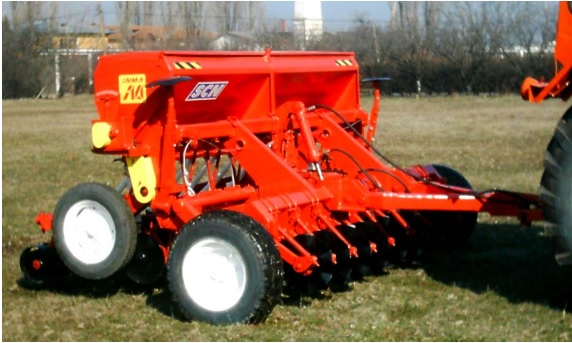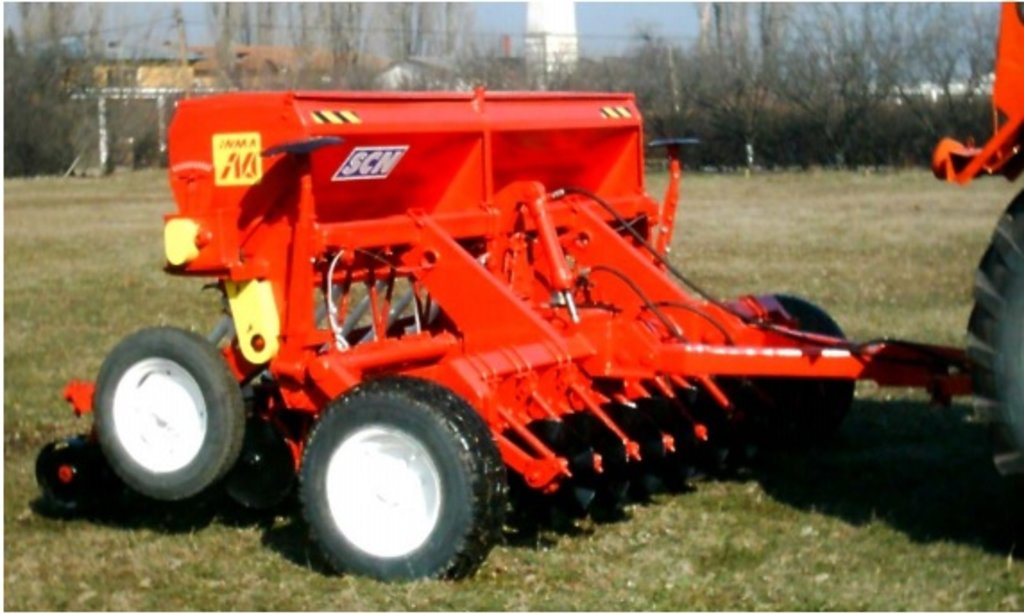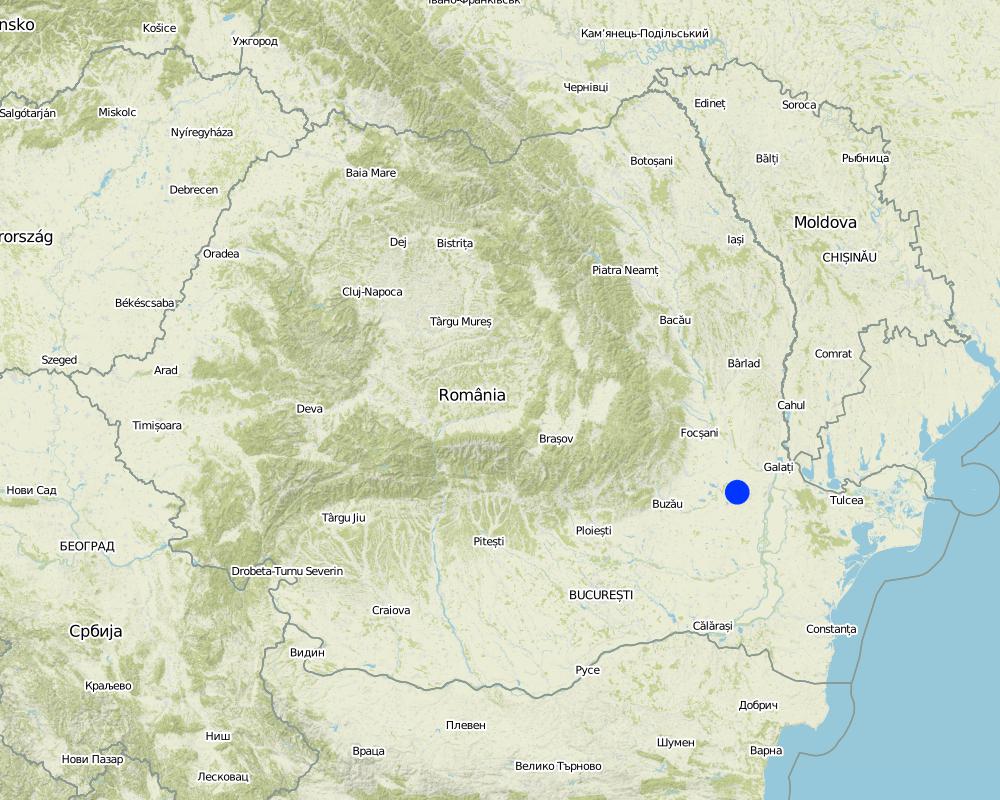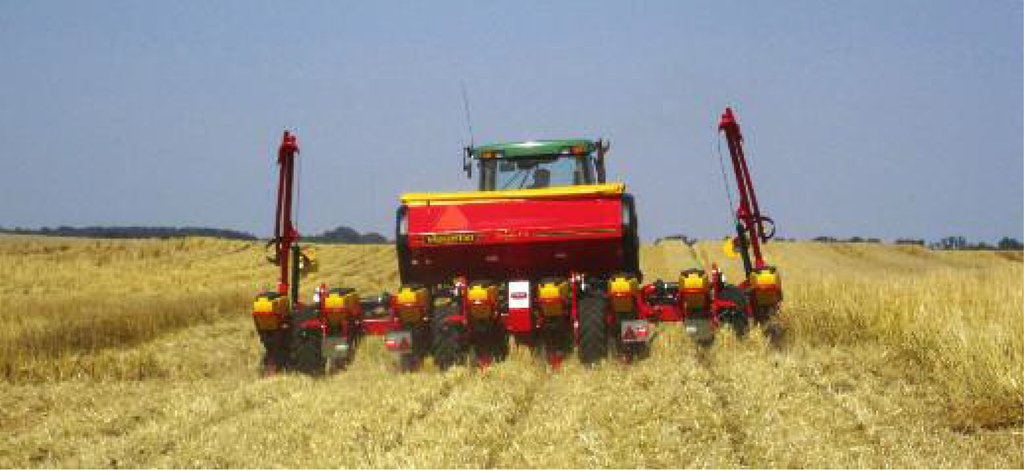Direct drill (no-till) for arable cropping systems [Romania]
- Creation:
- Update:
- Compiler: Olga Vizitiu
- Editor: –
- Reviewers: Ursula Gaemperli, Gudrun Schwilch, Nina Lauterburg, Alexandra Gavilano
technologies_2957 - Romania
View sections
Expand all Collapse all1. General information
1.2 Contact details of resource persons and institutions involved in the assessment and documentation of the Technology
Name of project which facilitated the documentation/ evaluation of the Technology (if relevant)
Interactive Soil Quality assessment in Europe and China for Agricultural productivity and Environmental Resilience (EU-iSQAPER)Name of the institution(s) which facilitated the documentation/ evaluation of the Technology (if relevant)
National Research and Development Institute for So (National Research and Development Institute for So) - Romania1.3 Conditions regarding the use of data documented through WOCAT
The compiler and key resource person(s) accept the conditions regarding the use of data documented through WOCAT:
Yes
1.4 Declaration on sustainability of the described Technology
Is the Technology described here problematic with regard to land degradation, so that it cannot be declared a sustainable land management technology?
No
2. Description of the SLM Technology
2.1 Short description of the Technology
Definition of the Technology:
Direct drill (no-till) for arable cropping systems. Crop establishment with minimum soil disturbance.
2.2 Detailed description of the Technology
Description:
The technology is applied in Braila region and is located in north-eastern part of Romanian Plain. It has an agricultural area of 387,646 ha (of which 350,001 ha are arable land), and has specific geomorphologic, hydrological and climatic conditions which need to use ameliorative agricultural systems. Within Braila County are distinguished the following relief units: Calmatui Plain, part of the Braila Plain (51% from County area) and the Floodplains of Danube (Big Island of Braila), Siret, Buzau and Calmatui rivers (49% from County area).
Braila Plain is characterized by a specific micro-relief of Baragan type with large floodplains, poorly fragmented, with altitudes ranging between 20-25 m in the east part and 35-40 m to the west part, with soils mainly of chernozem type, formed on loess and loess deposits and which shows numerous small depression areas. Floodplains, areas adjacent to Danube, Siret, Buzau and Calmatui rivers are located at lower altitudes, ranging between 2-4 m and 13-15 m and are characterized by the presence of alluvial soils formed on river-limnic and alluvial deposits, with alternating of layers with different textures. According to United Nations Convention to Combat Desertification, Braila County is located in arid region with an average annual temperature of 10.9°C, long-term average annual precipitations (P) of 447 mm, potential evapotranspiration (ETP) of 705 mm (750-800 mm in dry years) and an average climatic water deficit of 258 mm (350-400 mm in dry years). The biophysical aridity index (P/ETP = 0.50-0.65) places the Braila region in area with moderate risk to desertification. Both intensive and extensive farming systems are practiced within Braila County. Intensive agriculture, characterized by high inputs and yield levels, is realized on large vegetal farms. On the other hand, extensive agriculture, with low input and yield levels, is practiced by farmers on small vegetal farms, and is so-called the semi-subsistent agriculture.
The direct drill (no-till) conservative tillage technology is an agronomic measure. It is practiced on medium to large size farms (from around 50 ha to more than 1000 ha) within the North-Eastern part of the Romanian Plain. Over the past years some farmers have changed their farming system from conventional to conservative. The main element of the technology is that the farmers use special agricultural machinery for direct seeding, and other tillage operations from conventional system, such as ploughing and disking, are not performed anymore. Also, under no-till farming system, the soil surface remains covered on 30% with plant residues from the pre-emergent crop.
The main purpose of the technology is to mitigate soil structure degradation due to less tillage passes on the land. The technology is applied on arable land with annual crops. The farmers have begun to adopt this technology due to reduction in fuel consumption and working hours. For this reason, the technology has economic advantages. The no-tillage system requires a special direct seeding machine, and this can be expensive. So, most of the farmers don't buy it on their own, but they rent the seeding machine from other farmers.
In the land user's view, the strengths of the technology are as follows: reduced fuel consumption, improved soil water regime and tillage of larger field areas with less personnel and less trafficability and workability. In addition, the weaknesses of the technology reported by the land user might be: difficulties in weeds and pests control due to spread of straw-borne diseases which can be countered by in-depth knowledge of biocides, and high investment costs for equipment purchase which can be met by application for non-reimbursable funds or renting the equipment from other farmers or agricultural contractors.
2.3 Photos of the Technology
2.5 Country/ region/ locations where the Technology has been applied and which are covered by this assessment
Country:
Romania
Region/ State/ Province:
Braila
Further specification of location:
Braila
Specify the spread of the Technology:
- evenly spread over an area
If precise area is not known, indicate approximate area covered:
- < 0.1 km2 (10 ha)
Comments:
Documentation of the technology is based on examination of field plots smaller than 0.1 km2.
Map
×2.6 Date of implementation
If precise year is not known, indicate approximate date:
- 10-50 years ago
2.7 Introduction of the Technology
Specify how the Technology was introduced:
- during experiments/ research
Comments (type of project, etc.):
The technology was firstly implemented in the early 2000's and described by the Agricultural Research and Development Station of Braila (ARDS Braila) which is subordinated to the Academy of Agricultural and Forestry Sciences. The station ARDS Braila conducts research and development in the following subjects: irrigation systems, agricultural technologies and improvement and reclamation of salted soils.
3. Classification of the SLM Technology
3.1 Main purpose(s) of the Technology
- reduce, prevent, restore land degradation
- preserve/ improve biodiversity
- adapt to climate change/ extremes and its impacts
3.2 Current land use type(s) where the Technology is applied

Cropland
- Annual cropping
Annual cropping - Specify crops:
- cereals - barley
- cereals - maize
- cereals - wheat (winter)
Number of growing seasons per year:
- 1
Comments:
Main crops (cash and food crops): winter wheat, winter barley, spring barley, maize
3.4 Water supply
Water supply for the land on which the Technology is applied:
- mixed rainfed-irrigated
3.5 SLM group to which the Technology belongs
- minimal soil disturbance
3.6 SLM measures comprising the Technology

agronomic measures
- A3: Soil surface treatment
A3: Differentiate tillage systems:
A 3.1: No tillage
3.7 Main types of land degradation addressed by the Technology

physical soil deterioration
- Pc: compaction
3.8 Prevention, reduction, or restoration of land degradation
Specify the goal of the Technology with regard to land degradation:
- reduce land degradation
4. Technical specifications, implementation activities, inputs, and costs
4.1 Technical drawing of the Technology
Technical specifications (related to technical drawing):
The technology is done by special agricultural machinery for direct seeding, and other tillage operations from conventional system, such as ploughing and disking, are not performed anymore. In addition, the fertilizers are applied at the same pass. Also, under no-till farming system, the soil surface remains covered on 30% with plant residues from the pre-emergent crop. The main purpose of the technology is to mitigate soil structure degradation due to less tillage passes on the land.
The direct seeding machinery is equipped with rotary cleaners designed to prevent the seeds being placed without direct soil contact.
Direct sowing combined with 5-10 cm deep fertilization provides plant nutrients from the very first stages of their development leading to higher productivity. Fertilizers placed at 15-30 cm deep stimulate the roots to grow and provide the necessary nutrients throughout the growing season. This applies even in periods of drought since nutrients are absorbed in deep layers.
Author:
National Research and Development Institute for Soil Science, Agrochemistry and Environment (ICPA) - Romania
4.2 General information regarding the calculation of inputs and costs
Specify how costs and inputs were calculated:
- per Technology area
Indicate size and area unit:
1 ha
Specify currency used for cost calculations:
- USD
If relevant, indicate exchange rate from USD to local currency (e.g. 1 USD = 79.9 Brazilian Real): 1 USD =:
4.12
Indicate average wage cost of hired labour per day:
17.60 USD
4.4 Costs and inputs needed for establishment
Comments:
No initial investment needed, as for the machinery land users are working with agricultural contractors from the neighboring area or other land users that own the equipment.
4.5 Maintenance/ recurrent activities
| Activity | Timing/ frequency | |
|---|---|---|
| 1. | direct sowing |
4.6 Costs and inputs needed for maintenance/ recurrent activities (per year)
| Specify input | Unit | Quantity | Costs per Unit | Total costs per input | % of costs borne by land users | |
|---|---|---|---|---|---|---|
| Labour | labour | person-days | 0.2 | 17.6 | 3.52 | 100.0 |
| Equipment | direct sowing | machine-hours | 1.0 | 20.78 | 20.78 | 100.0 |
| Total costs for maintenance of the Technology | 24.3 | |||||
| Total costs for maintenance of the Technology in USD | 5.9 | |||||
4.7 Most important factors affecting the costs
Describe the most determinate factors affecting the costs:
Costs are mostly affected by input costs (e.g. seeds, biocides). Costs do not include investment in the special agricultural machinery for direct seeding because the farmers rely on borrowing/leasing the equipment from other land users or agricultural contractors from the neighboring area.
5. Natural and human environment
5.1 Climate
Annual rainfall
- < 250 mm
- 251-500 mm
- 501-750 mm
- 751-1,000 mm
- 1,001-1,500 mm
- 1,501-2,000 mm
- 2,001-3,000 mm
- 3,001-4,000 mm
- > 4,000 mm
Specify average annual rainfall (if known), in mm:
447.00
Agro-climatic zone
- semi-arid
5.2 Topography
Slopes on average:
- flat (0-2%)
- gentle (3-5%)
- moderate (6-10%)
- rolling (11-15%)
- hilly (16-30%)
- steep (31-60%)
- very steep (>60%)
Landforms:
- plateau/plains
- ridges
- mountain slopes
- hill slopes
- footslopes
- valley floors
Altitudinal zone:
- 0-100 m a.s.l.
- 101-500 m a.s.l.
- 501-1,000 m a.s.l.
- 1,001-1,500 m a.s.l.
- 1,501-2,000 m a.s.l.
- 2,001-2,500 m a.s.l.
- 2,501-3,000 m a.s.l.
- 3,001-4,000 m a.s.l.
- > 4,000 m a.s.l.
Indicate if the Technology is specifically applied in:
- not relevant
5.3 Soils
Soil depth on average:
- very shallow (0-20 cm)
- shallow (21-50 cm)
- moderately deep (51-80 cm)
- deep (81-120 cm)
- very deep (> 120 cm)
Soil texture (topsoil):
- medium (loamy, silty)
Soil texture (> 20 cm below surface):
- medium (loamy, silty)
Topsoil organic matter:
- medium (1-3%)
5.4 Water availability and quality
Ground water table:
5-50 m
Availability of surface water:
medium
Is water salinity a problem?
No
Is flooding of the area occurring?
No
5.5 Biodiversity
Species diversity:
- medium
Habitat diversity:
- medium
5.6 Characteristics of land users applying the Technology
Sedentary or nomadic:
- Sedentary
Market orientation of production system:
- mixed (subsistence/ commercial)
Off-farm income:
- less than 10% of all income
Relative level of wealth:
- average
Individuals or groups:
- individual/ household
Level of mechanization:
- mechanized/ motorized
Gender:
- men
Age of land users:
- middle-aged
Indicate other relevant characteristics of the land users:
The technology was firstly implemented by the Agricultural Research and Development Station of Braila.
5.7 Average area of land used by land users applying the Technology
- < 0.5 ha
- 0.5-1 ha
- 1-2 ha
- 2-5 ha
- 5-15 ha
- 15-50 ha
- 50-100 ha
- 100-500 ha
- 500-1,000 ha
- 1,000-10,000 ha
- > 10,000 ha
Is this considered small-, medium- or large-scale (referring to local context)?
- large-scale
5.8 Land ownership, land use rights, and water use rights
Land ownership:
- state
- individual, not titled
Land use rights:
- leased
5.9 Access to services and infrastructure
health:
- poor
- moderate
- good
education:
- poor
- moderate
- good
technical assistance:
- poor
- moderate
- good
employment (e.g. off-farm):
- poor
- moderate
- good
markets:
- poor
- moderate
- good
energy:
- poor
- moderate
- good
roads and transport:
- poor
- moderate
- good
drinking water and sanitation:
- poor
- moderate
- good
financial services:
- poor
- moderate
- good
6. Impacts and concluding statements
6.1 On-site impacts the Technology has shown
Socio-economic impacts
Production
land management
Comments/ specify:
Technology enables farmers to work more land areas at lower costs and with less equipments. So, they can increase their farm areas.
Income and costs
expenses on agricultural inputs
Comments/ specify:
Direct sowing equipments are expensive.
workload
Comments/ specify:
Less personnel costs are required.
Socio-cultural impacts
SLM/ land degradation knowledge
Comments/ specify:
Knowledge about this technology can be also obtained by farmers from the Agricultural Research and Development Station of Braila
Ecological impacts
Soil
soil moisture
Comments/ specify:
The plant residues from soil surface prevent the soil water loss by evaporation.
soil organic matter/ below ground C
Comments/ specify:
Leaving the plant residues from the previous crop at the soil surface can improve the soil organic matter content.
Biodiversity: vegetation, animals
beneficial species
Comments/ specify:
Leaving the plant residues from the previous crop at the soil surface has beneficial impact on soil fauna.
6.2 Off-site impacts the Technology has shown
wind transported sediments
Comments/ specify:
Leaving the plant residues from the previous crop at the soil surface after harvest reduces wind transported sediments slightly.
6.3 Exposure and sensitivity of the Technology to gradual climate change and climate-related extremes/ disasters (as perceived by land users)
Gradual climate change
Gradual climate change
| Season | increase or decrease | How does the Technology cope with it? | |
|---|---|---|---|
| annual temperature | increase | well | |
| annual rainfall | decrease | well |
Climate-related extremes (disasters)
Meteorological disasters
| How does the Technology cope with it? | |
|---|---|
| local rainstorm | well |
6.4 Cost-benefit analysis
How do the benefits compare with the establishment costs (from land users’ perspective)?
Short-term returns:
slightly positive
Long-term returns:
positive
How do the benefits compare with the maintenance/ recurrent costs (from land users' perspective)?
Short-term returns:
slightly positive
Long-term returns:
positive
6.5 Adoption of the Technology
- 1-10%
Of all those who have adopted the Technology, how many did so spontaneously, i.e. without receiving any material incentives/ payments?
- 91-100%
Comments:
One land user has implemented the technology voluntary.
6.6 Adaptation
Has the Technology been modified recently to adapt to changing conditions?
No
6.7 Strengths/ advantages/ opportunities of the Technology
| Strengths/ advantages/ opportunities in the land user’s view |
|---|
| Farmers can manage larger field areas with less personnel and less trafficability and workability |
| Reduced fuel consumption |
| Improved soil water regime |
| Strengths/ advantages/ opportunities in the compiler’s or other key resource person’s view |
|---|
| Improved soil organic matter and soil structure |
| Enhanced soil biological activity |
6.8 Weaknesses/ disadvantages/ risks of the Technology and ways of overcoming them
| Weaknesses/ disadvantages/ risks in the land user’s view | How can they be overcome? |
|---|---|
| High investment costs for equipment purchase | agricultural contractors or application for non-reimbursable funds |
| Difficulties in weeds and diseases control | knowledge about biocides |
| Weaknesses/ disadvantages/ risks in the compiler’s or other key resource person’s view | How can they be overcome? |
|---|---|
| The farmer's mentality from local area towards conservation agriculture is constraining the adoption of the system by other farmers. | continuous demonstration and dissemination about benefits of the technology |
7. References and links
7.1 Methods/ sources of information
- field visits, field surveys
1
- interviews with land users
2
- compilation from reports and other existing documentation
1
When were the data compiled (in the field)?
29/09/2017
7.2 References to available publications
Title, author, year, ISBN:
"Lucrarea conservativa a solului intre traditie si perspectiva in agricultura durabila" (Conservative tillage of soil between tradition and perspective in sustainable agriculture), Elisabeta Dumitru et. al., 2005, ISBN 973-86587-9-9.
Links and modules
Expand all Collapse allLinks
No links
Modules
No modules






